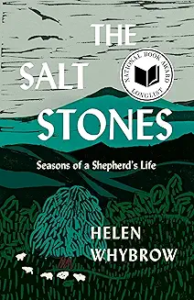The Salt Stones: Seasons of a Shepherd’s Life by Helen Whybrow 2025
Whybrow grew up on a working farm in Plainfield, NH just a few miles as the crow flies over Mt. Ascutney from our home in Vermont. After trying various lifestyles in her 20’s, she falls in love and moves to a 100 acre hill farm in Waitsfield, Vermont. Her description of these two sites is filled with allusions that strongly echoed in my soul: the Cornish Colony, Maxfield Parrish blue, William Jarvis, Weathersfield Bow and Merino sheep, Mt. Abraham, the Warren Store….
But even without these familiar shared touchstones, I would have responded to Whybrow’s idyll to her sheep farm and her philosophy of pastoralism. It’s an interesting concept which involves a relationship with animals different from viewing them as pets or units of production. This third way bases the “relationship on so many things—companionship, love, ceremony, livelihood, food, clothing, and also an important doorway into the wild community of plants and beings that are all around us and are not so easily seen…It involves trading efficiency for relationship, for an innate sense of reciprocity with land, animals, and people.”
Whybrow is also deeply aware of the cycle of life and death, a cycle that is evident daily on the farm and powerfully affects her deepening relationships with her mother and her daughters, Willow and Wren. She writes, “I have come to a profound juncture. I don’t want loss to upend me. I am calling on things I have learned in this shepherding life of grace and joy, of death and risk, of endings and beginnings, of edges and the unknown, of letting go. I am searching for those stories, stories like salt, stories about mothers, grandmothers, and daughters.”
This book had the potential to turn me off with its almost ‘goodie goodie’ sense of nature, social justice, hard work, etc. and the occassional purple passage of prose, but her writing was just too good to abandon. Here’s an example of its power and beauty: “The four of us sit at the kitchen table in the clear fall sunlight, the door propped open and the dogs comng and going underfoot like small children announcing imaginary games. They, like us, seem to sense a change in the sharpening air. Beyond the window a fleet of leaves sails south across the pond to crowd at the far edge, to sink and solidify in the layers, to move from air to water to the winter lair of fish and frogs. Skeins of geese drape low over the fields aiming for the river, wings tilting as they slow their flight, their talk incessant and laden with longing for where they are going, where they have been.”
Wow. She described what I felt when I walked today on a cold September morning along the dirt roads in Vermont and expressed it far beyond what I’m capable of. That’s enough reason to read this book, but then there’s her word choice—transhumance, hefting, skirting, suint, kulning—which provided another whole dimension and many opportunities to go to Google for definitions.
For some reason, shepherds more than other people seem to feel the need to share their wonder with the world with readers. There’s James Rebanks and his three books about sheep herding in Yorkshire and Don Mitchell’s three books including “Growing Up Country: Raising a Family and Flock in a Rural Place” about his move to rural Vermont to raise sheep. And then there’s “Goat Song” by Brad Kessler about his Vermont goat farm, and many more. Perhaps it’s the same drive that moves most writers, the overflowing emotions, ideas, and feelings that the world stimulates in them leading to the need to write it down. I, for one, am grateful and look forward to more shepherds’ works.
This is a beautiful book, one to be read slowly and deeply. Thanks to Liz A. for suggesting it.



